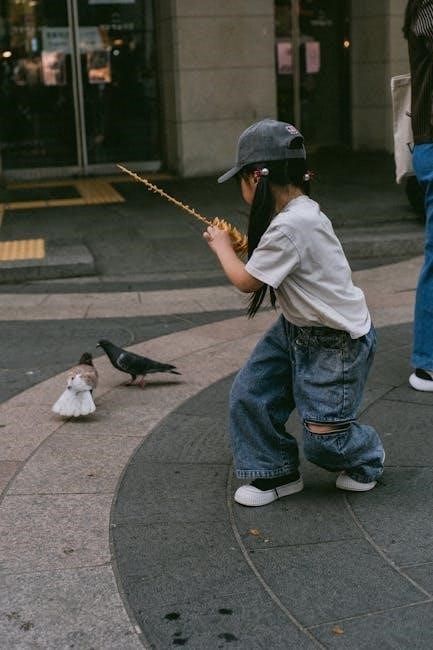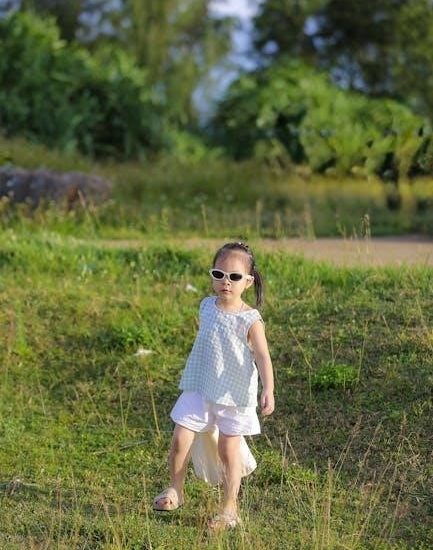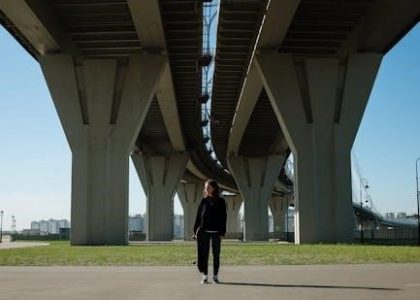Hurricane Diane, a provocative comedy by Madeleine George, blends Greek mythology with modern satire. The play explores themes of climate change, identity, and societal complacency, offering a unique theatrical experience.
1.1 Brief Overview
Hurricane Diane is a bold and unconventional play by Madeleine George that intertwines Greek mythology with modern satire. The story revolves around Diane, a permaculture gardener who is, in truth, the Greek god Dionysus in disguise. With her butch charm and supernatural abilities, Diane aims to awaken suburban women to the looming ecological crisis. Set in a quiet New Jersey neighborhood, the play uses humor and tragedy to explore themes of climate change, identity, and societal complacency. George’s witty dialogue and creative storytelling transform an ancient myth into a contemporary commentary on urgent global issues. The play has garnered critical acclaim for its unique blend of comedy and social critique, making it a standout piece in modern theater. Its innovative approach to addressing real-world problems has resonated with audiences, solidifying its place as a thought-provoking and entertaining production.

1.2 Historical Context
Hurricane Diane premiered in 2017, marking a significant moment in contemporary theater. Drawing inspiration from Euripides’ The Bacchae, the play reimagines Dionysus as Diane, a modern, butch gardener with divine powers. Written by Madeleine George, the play reflects her interest in blending mythology with pressing modern issues like climate change. The production gained traction for its bold commentary on societal complacency and environmental neglect. Its debut coincided with heightened global awareness of climate crises, resonating deeply with audiences. The play’s success led to widespread recognition, including an Obie Award, and it has since been performed at numerous regional theaters. Hurricane Diane stands as a testament to theater’s ability to address urgent issues through innovative storytelling, making it a landmark work in 21st-century drama. Its historical context is rooted in both ancient mythology and contemporary concerns, offering a unique lens through which to view global challenges.

Background
Hurricane Diane, written by Madeleine George, is a bold mix of mythology and modern satire. Premiering in 2017, this Obie-winning play critiques climate change and societal norms through its innovative storytelling and direction by Leigh Silverman.
2.1 Inspiration and Creation
Madeleine George drew inspiration from Greek mythology, particularly Dionysus, to craft Hurricane Diane. The play combines the god’s chaotic power with modern themes like climate change and suburban life, creating a unique narrative. George aimed to highlight societal complacency through humor and satire, blending the divine with the mundane. The character of Diane, a permaculture gardener with godly abilities, embodies this fusion. George’s creative process involved reimagining ancient myths for contemporary audiences, using satire to address urgent issues. The play’s development reflects her interest in exploring identity and environmentalism, resulting in a work that is both entertaining and thought-provoking. This blend of mythology and modernity sets Hurricane Diane apart as a bold theatrical statement.
2.2 Premiere and Production History
Hurricane Diane premiered in 2017, produced by WP Theater and New York Theatre Workshop. Directed by Leigh Silverman, it quickly gained attention for its bold blend of satire and mythology. The play’s success led to productions at regional theaters nationwide, solidifying its reputation as a compelling contemporary work. Its 2025 run at Hartford Stage further showcased its enduring relevance, highlighting themes of climate change and societal complacency. The play’s production history reflects its ability to resonate with diverse audiences, making it a standout in modern theater. The Obie-winning production continues to be celebrated for its innovative storytelling and timely commentary, ensuring its place in the spotlight of American theater.
Plot Summary
Hurricane Diane follows Diane, a permaculture gardener with supernatural abilities, as she navigates modern suburbia. Blending mythology and satire, the play explores themes of climate change and societal complacency, weaving humor with urgency.
3.1 Setting

The play is set in a contemporary New Jersey suburb, blending the mundane routines of suburban life with the supernatural presence of Diane, a permaculture gardener who is actually the Greek god Dionysus. This juxtaposition of modernity and mythology creates a unique backdrop for exploring themes of climate change, identity, and societal complacency. The suburban setting, with its neatly manicured lawns and privileged residents, serves as a metaphor for the broader societal indifference to environmental crises. Diane’s interactions with the suburban women highlight the clash between their self-absorbed lives and the urgency of ecological disaster. The setting also allows for a blend of humor and tragedy, as the characters navigate their personal struggles against the backdrop of impending environmental catastrophe. Through this setting, the play critiques contemporary culture while drawing parallels to ancient myths, creating a rich and layered narrative.
3.2 Detailed Synopsis
Hurricane Diane follows the story of Diane, a permaculture gardener with supernatural abilities, who is actually the Greek god Dionysus in disguise. Arriving in a New Jersey suburb, Diane aims to lead a group of self-absorbed housewives toward environmental action and spiritual awakening. The play begins with Diane’s charm and wit slowly influencing the women, but their initial resistance and personal struggles complicate her mission. As the story unfolds, Diane’s divine powers and the impending threat of an ecological disaster force the women to confront their complacency. The narrative weaves humor and tragedy, exploring themes of climate change, identity, and societal transformation. Through Diane’s efforts, the women undergo a metamorphosis, embracing both their inner desires and the urgent need for environmental stewardship. The play culminates in a dramatic confrontation with nature, symbolizing the possibility of change and redemption in the face of global crisis.

Characters
Diane/Dionysus, a butch charm permaculture gardener with supernatural abilities, embodies the Greek god Dionysus. The suburban women, self-absorbed housewives, resist Diane’s influence, adding humor and depth to the narrative through their personal struggles and transformation.
4.1 Diane/Dionysus
Diane, also known as Dionysus, is a central character in Hurricane Diane, blending the Greek god of wine and theater with a modern, butch gardener. Her dual identity allows her to navigate both the human and divine realms, using her charm and wit to influence the suburban women she encounters. Diane’s primary goal is to lead them toward environmental awareness and personal transformation, leveraging her supernatural abilities to disrupt their complacent lives. Her character serves as a catalyst for change, combining humor with a deeper commentary on climate change and societal norms. Through Diane, playwright Madeleine George explores themes of identity, power, and the intersection of mythology and modern life, creating a compelling and complex figure that drives the play’s narrative forward; Diane’s role is both comedic and profound, making her a standout character in contemporary theater.
4.2 The Suburban Women

The suburban women in Hurricane Diane are portrayed as self-absorbed, materialistic, and disconnected from environmental issues. They represent a microcosm of modern society, where personal comforts often overshadow global crises. These characters are humorously yet critically depicted as they navigate their superficial lives, initially oblivious to Diane’s true nature and her mission to awaken them. Their interactions with Diane serve as a catalyst for their gradual transformation, forcing them to confront their own complicity in ecological destruction. Through their journey, the play critiques suburban culture and the complacency of the privileged, highlighting the tension between individualism and collective responsibility. The women’s evolution from ignorance to awareness underscores the play’s themes of climate change and social commentary, making them integral to the narrative’s development and message.
Themes
Hurricane Diane explores climate change, blending mythology with modernity, and critiques societal complacency. It delves into identity, privilege, and environmental urgency, using satire to highlight human failings and the need for collective action.
5.1 Climate Change

At the heart of Hurricane Diane lies a searing critique of climate change. The play masterfully intertwines the mythological narrative of Dionysus with contemporary environmental concerns, using humor and satire to highlight human complacency. Diane, as Dionysus, represents both a force of nature and a catalyst for change, urging suburban women to confront their role in ecological destruction. The permaculture garden serves as a symbol of sustainable living, contrasting sharply with the characters’ indifference to environmental collapse. Madeleine George’s work does not shy away from the severity of the issue, instead, it amplifies the urgency through a blend of comedy and tragedy. The play challenges audiences to reflect on their own contributions to climate change, making it a powerful commentary on modern society’s relationship with the planet. By framing climate change as both a personal and collective responsibility, Hurricane Diane becomes a call to action, wrapped in a compelling narrative.
5.2 LGBTQ+ Representation
Hurricane Diane offers a vibrant exploration of LGBTQ+ themes, particularly through its protagonist Diane, a butch permaculture gardener with undeniable charm and swagger. Diane’s identity as a queer woman is central to the narrative, blending seamlessly with her role as Dionysus. The play celebrates queer identity, presenting it as a source of strength and transformation. Diane’s interactions with the suburban women challenge traditional gender roles and societal norms, fostering a dialogue about fluidity and acceptance. Madeleine George’s portrayal of Diane as a confident, masculine-of-center character provides much-needed representation, making the play a significant work in LGBTQ+ theatre. The humor and wit with which Diane navigates her dual identity as both a gardener and a god highlight the richness of queer experiences. By centering a queer character in a story about environmental and social change, Hurricane Diane underscores the importance of diverse voices in shaping a better future.
5.3 Intersection of Mythology and Modernity
Hurricane Diane masterfully intertwines ancient Greek mythology with contemporary suburban life, reimagining Dionysus as Diane, a charming permaculture gardener. This modern retelling of the Bacchae myth places a god in a mundane setting, exploring themes of environmentalism and societal transformation. Diane’s divine identity contrasts sharply with her role as a gardener, symbolizing the clash between natural harmony and human neglect of the planet. The play’s use of mythological elements, such as Diane’s supernatural abilities, serves as a metaphor for the urgent need for change in the face of climate crises. By blending the timeless with the timely, George creates a narrative that feels both familiar and fresh, inviting audiences to reflect on their relationship with the environment and each other. The intersection of mythology and modernity in Hurricane Diane highlights the enduring relevance of ancient stories in addressing today’s challenges.
5.4 Satire and Social Commentary
Hurricane Diane uses biting satire to critique modern societal attitudes, particularly toward climate change and suburban culture. Diane, a butch permaculture gardener with divine powers, embodies both charm and a sharp wit, exposing the absurdity of human complacency. The play mocks the self-absorption of suburban women, highlighting their detachment from environmental realities. Through humor and irony, George critiques the superficiality of middle-class life, where aesthetic concerns often overshadow ecological crises. Diane’s interactions with the women serve as a metaphor for the larger societal struggle to confront climate change. The play’s satirical tone balances humor with a sobering message, urging audiences to reflect on their role in environmental degradation. By blending comedy with sharp social commentary, Hurricane Diane challenges viewers to question their priorities and consider the consequences of inaction. This approach makes the play both entertaining and thought-provoking, offering a fresh perspective on pressing global issues.
Creative Elements
Madeleine George’s playwriting style in Hurricane Diane masterfully blends wit and social commentary. Leigh Silverman’s direction balances humor and tragedy, while vibrant stage and costume design enhance the play’s mythical and modern contrasts.
6.1 Madeleine George’s Playwriting Style
Madeleine George’s playwriting style in Hurricane Diane is a vibrant fusion of wit, satire, and emotional depth. Her dialogue is sharp and engaging, often using humor to underscore the urgency of climate change. George masterfully weaves together elements of Greek mythology and modern suburban life, creating a unique narrative voice that is both accessible and thought-provoking. Her characters are multidimensional, with distinct personalities that drive the story forward while exploring themes of identity and societal complacency. George’s ability to balance comedy and tragedy is a hallmark of her work, making Hurricane Diane a compelling and unforgettable theatrical experience. Her writing not only entertains but also challenges audiences to reflect on their role in addressing environmental issues, showcasing her skill as a contemporary playwright with a keen social conscience;
6.2 Direction by Leigh Silverman
Leigh Silverman’s direction in Hurricane Diane brings a dynamic energy to Madeleine George’s script, seamlessly blending the play’s comedic and tragic elements. Silverman’s approach emphasizes the absurdity of the suburban setting while highlighting the urgency of the environmental themes. Her staging is both intimate and expansive, allowing the audience to connect with the characters’ personal struggles and the larger mythological framework. Silverman’s use of pacing and tone ensures that the play’s humor does not overshadow its deeper messages, creating a balanced and impactful experience. Her collaboration with the cast and design team results in a cohesive production that enhances the play’s exploration of identity, community, and ecological crisis. Silverman’s direction has been praised for its creativity and sensitivity, making Hurricane Diane a standout production in contemporary theater.

6.3 Stage and Costume Design
The stage and costume design in Hurricane Diane play a pivotal role in bringing the story to life. The set often features a suburban backyard, juxtaposing natural elements with the artificiality of modern life. Costumes reflect the characters’ personalities, with Diane’s butch charm emphasized through practical, androgynous attire. The design elements are deeply intertwined with the play’s themes of climate change and identity, using vibrant colors and organic textures to symbolize the clash between nature and human neglect. The stage’s permaculture-inspired elements, such as lush greenery, underscore Diane’s mission to transform her environment. Meanwhile, the costumes of the suburban women evolve throughout the play, mirroring their internal transformations. The overall design creates a visually striking contrast between the mundane and the divine, enhancing the play’s blend of humor and tragedy. This aesthetic approach immerses the audience in the world of the play, making its themes resonate more profoundly.

Key Scenes and Dialogue
Hurricane Diane features pivotal scenes where Diane’s charm and supernatural abilities drive the plot. Her interactions with the suburban women blend humor with deeper themes, creating a compelling narrative that captivates audiences emotionally.
7.1 Analysis of Pivotal Moments
Hurricane Diane is rich with pivotal moments that blend comedy and emotional depth. A key scene involves Diane’s supernatural revelation to the suburban women, showcasing her charm and divine authority. This moment shifts the dynamics, forcing the women to confront their environmental impact. The dialogue is sharp, balancing humor with poignant commentary on climate change. Another critical moment is when Diane’s true identity as Dionysus is unveiled, highlighting the intersection of mythology and modernity. These scenes are masterfully directed, using satire to critique societal complacency while maintaining emotional resonance. The play’s ability to weave tragedy and comedy creates a compelling narrative that lingers with audiences long after the curtain falls. These pivotal moments not only drive the plot but also underscore the play’s central themes of transformation and accountability.
7;2 Use of Comedy and Tragedy
Madeleine George’s Hurricane Diane masterfully intertwines comedy and tragedy, creating a dynamic theatrical experience. The play uses comedic elements, such as the suburban women’s eccentricities, to highlight their obliviousness to environmental crises. Diane’s charm and wit add a layer of humor, while her divine frustration injects tragic undertones. The contrast between the trivial concerns of the women and the impending ecological disaster amplifies the satirical tone. Tragic moments emerge as the characters confront the consequences of their actions, blending poignancy with absurdity. This balance of genres keeps the audience engaged, making the play both entertaining and thought-provoking. The fusion of comedy and tragedy underscores the urgency of the themes, offering a unique perspective on climate change and societal responsibility. By juxtaposing these elements, George creates a memorable and impactful narrative that resonates deeply.

Symbolism and Metaphors
Hurricane Diane is rich in symbolism, with Diane/Dionysus embodying transformation and chaos. The storm metaphorically represents climate change’s destructive power, while permaculture symbolizes harmony with nature, contrasting suburban complacency and ecological decay.
8.1 The Role of Permaculture
Permaculture in Hurricane Diane serves as a metaphor for sustainable living and environmental harmony. Diane, as a permaculture gardener, embodies the ideals of regenerative practices, contrasting the suburbanites’ disconnection from nature. Her efforts symbolize humanity’s potential to heal the planet, while the storm underscores the consequences of neglecting ecological balance. The play uses permaculture to highlight the clash between modernity and nature, emphasizing the need for collective action against climate change. Through Diane’s character, permaculture becomes a powerful symbol of hope and transformation, urging audiences to rethink their relationship with the environment. This theme is central to the play’s message, blending humor with a critical commentary on contemporary environmental issues.





